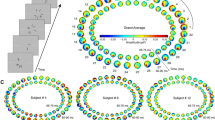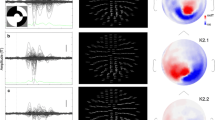Summary
A study was made of the transverse distributions of human scalprecorded potentials evoked by the brief presentation of a pattern into different regions of a continuously illuminated diffuse field. The first two components of these visual evoked potentials (VEPs), designated C.I. (latency 65–80 msec) and C. II (latency 90–110 msec), were both greatly influenced by the retinal location of the stimulus pattern. In an initial study of the VEP waveforms with 12 subjects, followed by a more detailed investigation of the distribution of the individual components in 4 subjects, the following results were found.
-
1.
Corresponding peaks (C. I and C. II) of the VEPs to stimulation of the upper and lower half-fields were inverted in polarity.
-
2.
For the left and right half-field VEPs, the transverse distribution of C. I, but not of C. II, showed a polarity reversal across the midline.
-
3.
Consistent differences were observed between the distributions of C. I for adjacent upper and lower quadrants, as well as between those for adjacent horizontal and vertical octants of the upper field.
-
4.
Subjects differed in the degree of left-right asymmetry shown. There was also a much greater degree of interindividual consistency of quadrant and upper and lower half-field VEPs than for full-field or left and right half-field responses.
-
5.
For C. I, an additive relationship was demonstrated between the half-field and the constituent quadrant VEP distributions.
These results indicate that C. I and C. II have spatially separate sources. Assuming a simple dipolar model based on the known retinotopic organization of the striate cortex, it is shown that the measured distributions are compatible with the hypothesis that component C. I, but not C. II, originates in striate cortex, from surface negative cortical activity.
Similar content being viewed by others
References
Biersdorf, W.R., Nakamura, Z.: Electroencephalogram potentials evoked by hemi-retinal stimulation. Experientia (Basel) 27, 402–403 (1971).
Bilge, M., Bingle, A.. Seneviratine, K.N., Whitteridge, D.: A map of the visual cortex in the cat. J. Physiol. (Lond.) 191, 116P-117P (1967).
Brazier, M.A.B.: A study of electrical fields at the surface of the head. Electroenceph. clin. Neurophysiol. Suppl., 2, 38–52 (1949).
Brindley, G.S., Lewin, W.S.: The sensations produced by electrical stimulation of the visual cortex. J. Physiol. (Lond.) 196, 479–493 (1968).
Cowey, A.: Projection of the retina on to striate and prestriate cortex in the squirrel monkey, Saimiri Sciureus. J. Neurophysiol. 27, 366–396 (1964).
Cragg, B.G.: The topography of the afferent projections in the circumstriate visual cortex of the monkey studied by the Nauta method. Vision Res. 9, 733–747 (1969).
Daniel, D.M., Whitteridge, D.: The representation of the visual field on the cerebral cortex in monkeys. J. Physiol. (Lond.) 159, 203–221 (1961).
Fourment, A., Jami, L., Calvet, J., Scherrer, J.: Comparaison de l'EEG recuelli sur le scalp avec l'activité elementaire des dipoles corticaux radiaires. Electroenceph. clin. Neurophysiol. 19, 217–229 (1965).
Geisler, C.D., Gerstein, G. L.: The surface EEG in relation to its sources. Electroenceph. clin. Neurophysiol. 13, 927–934 (1961).
Goff, W.R., Matsumiya, Y., Allison, T., Goff, G.D.: Cross-modality comparisons of averaged evoked potentials. In: Donchin, E. and Lindsley, D.B. (eds.). Average evoked potentials, pp. 95–141. Washington, D.C.: NASA SP-191, 1969.
Halliday, A.M., Michael, W.F.: Changes in pattern-evoked responses in man associated with the vertical and horizontal meridians of the visual field. J. Physiol. (Lond.) 208, 499–513 (1969).
Holmes, G.: The organization of the visual cortex in man. Proc. roy. Soc. B. 132, 348–361 (1945).
Hubel, D.H., Wiesel, T.N.: Receptive fields, binocular interaction and functional architecture in the cat's visual cortex. J. Physiol. (Lond.) 160, 106–154 (1962).
—: Receptive fields and functional narchitecture in two non-striate visual areas (18 and 19) of the cat. J. Neurophysiol. 28, 1041–1059 (1965).
—: Cortical and callosal nconnections concerned with the vertical meridian of visual fields in the cat. J. Neurophysiol. 30, 1562–1573 (1967).
— Receptive fields and functional gnarchitecture of monkey striate cortex. J. Physiol. (Lond.) 195, 215–243 (1968).
Jami, L., Fourment, A., Calvet, J., Thieffry, M.: Étude sur modèle des methodes de detection EEG. Electroenceph. clin. Neurophysiol. 24, 130–145 (1968).
Jeffreys, D.A.: Separable components of human evoked responses to spatially patterned visual fields. Electroenceph. clin. Neurophysiol. 24, 596 (1968).
-In: Mackay, D.M., Evoked brain potentials as indicators of sensory information processing. Neurosciences Res. Prog. Bull. 7, 208–216 (1969).
—: Striate and extrastriate origins of pattern-related visual evoked potential components. J. Physiol. (Lond.) 211, 29P-30P (1970).
—: Source locations of pattern-related visual evoked potential components. Electroenceph. clin. Neurophysiol. 30, 367 (1971a).
—: Cortical source locatios of pattern-related visual evoked potentials recorded from the human scalp. Nature (Lond.) 229, 502–504 (1971b).
— Axford, J.G.: Source locations of pattern-specific components of human visual evoked potentials. II. Component of extrastriate cortical origin. Exp. Brain Res. 16, 22–40 (1972).
Kelly, D.L., Goldring, S., O'Leary, J.: Averaged evoked somatosensory responses from expo-sed cortex of man. Arch. Neurol. (Chic.) 13, 1–9 (1965).
Kooi, K.A., Tipton, A.C., Marshall, R.E.: Polarities and field configuration of the vertex components of the human auditory evoked response: a reinterpretation. Electroenceph. clin. Neurophysiol. 31, 166–169 (1971).
Mackay, D.M.: Evoked brain potentials as indicators of sensory information processing. Neurosciences Res. Prog. Bull. 7, 181–276 (1969).
— Jeffreys, D.A.: Visual evoked potentials and visual perception in man. In: Jung, R. (ed.)., Handbook of sensory physiology, Vol. VII/3. Berlin-Heidelberg-New York: Springer 1972.
Marg, E., Adams, J.E., Rutkin, B.: Receptive fields of cells in human visual cortex. Experientia (Basel) 24, 348–350 (1968).
Michael, W.F., Halliday, A.M.: Visually evoked responses to patterned stimuli in different octants of the visual field. Electroenceph. clin. Neurophysiol. 29, 106 (1970).
Michael, W.F., Halliday, A.M.: Differences between the occipital distribution of upper and lower field pattern-evoked responses in man. Brain Res. 32, 311–324 (1971).
Paicer, P.L., Sances, A., Larson, S.J.: Theoretical evaluation of cerebral evoked potentials. Proc. 20th. A.C.E.M.B., paper 14.1. (1967).
Polyak, S.: The vertebrate visual system. Chicago: Univ. of Chicago Press 1957.
Regan, D.: Evoked potentials in psychology, sensory physiology and clinical medicine. London: Chapman and Hall 1971.
Rémond, A., Morton, H.B., Cobb, W.A.: Topographic observations on visual pattern-evoked potentials. Electroenceph. clin. Neurophysiol. 26, 536 (1969).
Rietveld, W.J., Tordoir, W.E.M., Hagenouw, J.R.B., van Dongen, W.K.J.: Contribution of foveo-parafoveal quadrants to the visual evoked response. Acta physiol. pharmacol. neerl. 13, 340–347 (1965).
Rush, S., Driscoll, D.A.: EEG electrode sensitivity — an application of reciprocity. I.E.E.E. Trans. BME 16, 15–22 (1969).
Schneider, M., Gerin, P.: Une methode de localization des dipoles cerebraux. Electroenceph. clin. Neurophysiol. 28, 69–78 (1970).
Shaw, J.C., Roth, M.: Potential distribution analysis. II. A theoretical consideration of its significance in terms of electrical field theory. Electroenceph. clin. Neurophysiol. 7, 285 to 292 (1955).
Spehlmann, R.: The averaged electrical responses to diffuse and to patterned light in the human. Electroenceph. clin. Neurophysiol. 19, 560–569 (1965).
Talbot, S.A., Marshall, W.H.: Physiological studies on neural mechanisms of visual locali-zation and discrimination. Amer. J. Ophthal. 24, 1255–1264 (1941).
Teuber, H.L., Battersby, W.S., Bender, M.B.: Visual field defects after penetrating missile wounds of the brain. Cambridge, Mass.: Harvard Univ. Press. 1960.
Tweel, L.H. van der, Regan, D., Spekreijse, H.: Some aspects of potentials evoked by changes in spatial brightness contrast. Proc. 7th. Int. Symp. ISCERG. 1–12 Istanbul: Univ. of Istanbul Med. Faculty 1971.
Vaughan, H.G.: The relationship of brain activity to scalp recordings of event-related potentials. In: Donchin, E. and Lindsley, D.B. (eds.). Average evoked potentials, pp. 45–94. Washington: NASA SP-191, 1969.
— Ritter, W.: The sources of auditory evoked responses recorded from the human scalp. Electroenceph. clin. Neurophysiol. 28, 360–367 (1970).
White, C.T.: Evoked cortical responses and patterned stimuli. Amer. Psychol. 24, 211–214 (1969).
Zeki, S.M.: Representation of central visual fields in prestriate cortex of monkeys. Brain Res. 14, 271–291 (1969).
Author information
Authors and Affiliations
Additional information
We are grateful to P.W. Lynch, J.S. Corbett, S. Hale and Miss M.A. Steele for their assistance in this work. J.G. Axford was supported by I.B.M. (U.K.) Laboratories Ltd. to whom grateful acknowledgement is given. 1 Exp. Brain Res. Vol. 16
Rights and permissions
About this article
Cite this article
Jeffreys, D.A., Axford, J.G. Source locations of pattern-specific components of human visual evoked potentials. I. Component of striate cortical origin. Exp Brain Res. 16, 1–21 (1972). https://doi.org/10.1007/BF00233371
Received:
Issue Date:
DOI: https://doi.org/10.1007/BF00233371




